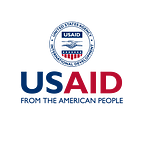Virgie’s Hope for Better Sanitation
How USAID helps Filipino families access affordable toilets and septic tanks
As the sun peeks over the horizon in Sarangani province, Philippines, 43-year-old Virgie Montero bustles around the house, preparing breakfast for her husband and four children before heading to work at her convenience store along the main road. Outside, her husband prepares to buy vegetables and fish at the local market, while her oldest son tends to the cow.
Virgie looks out the window and smiles. Just steps from her front door stands a newly constructed sanitary toilet with sturdy walls, a septic tank, and its own water source — built with support from USAID and its partners. As Virgie sips her coffee, she thinks about the benefits it has brought to her family.
“Having a sanitary toilet is truly about health,” said Virgie. “If you don’t have a septic tank and proper flooring for your toilet, germs and fecal matter are absorbed into the ground and could potentially get into our water or even our food sources.”
Around 6 million Filipinos do not have access to sanitary toilets, and 4 million still resort to open defecation. This lack of adequate facilities leads to contamination of fresh water sources and can pose risks of waterborne diseases.
“Before we had our own toilet, we just used a communal one with galvanized sheet iron for walls,” Virgie remembered. “It’s truly difficult not having your own toilet with a reliable water source. Where will you go — in the fields?”
Before Virgie and her family had a sanitary toilet, Virgie’s husband and two of her children contracted severe diarrhea and were hospitalized. Tears well up in her eyes as she remembers the struggles of trying to earn enough money to keep food on the table and pay the hospital bills.
“It was truly hard at that time,” Virgie remembered. “With a sanitary toilet and septic tank, we know that our water is safe to drink.”
In partnership with global development company DAI, microfinancing institution ASA Philippines, and local governments, USAID installed 100 sanitary toilets that benefit Virgie and nearly 500 other individuals in the provinces of Sarangani and Negros Occidental, which have some of the country’s lowest access to water and sanitation services. This was made possible through an innovative, pay-for-results financing pilot that combines public grants with personal microfinance loans for improved water, sanitation, and hygiene.
This financing mechanism makes sanitary toilets affordable for poor households, as public grants subsidize the more costly septic tanks, while mico-loans cover the toilet portion of the structure. USAID facilitated the pilot, the design of the septic tanks, and the pilot program’s documentation to inform local and national sanitation programs. This initiative also empowers women to manage their sanitation loans, protect their families’ health, and build a better future for themselves and their families.
“If it wasn’t for the subsidy and the loan, I wouldn’t have been able to afford our sanitary toilet,” said Virgie. “Now, despite our limited income, I can pay for it and still have enough money for our food and other basic needs.”
Across the globe, USAID works to increase the availability and sustainable management of safe water and sanitation for the underserved and most vulnerable. In the Philippines, USAID partners with local governments, the private sector, and communities to increase access to resilient water supply and sanitation services as part of the overall goal to improve long-term water security.
“Having a sanitary toilet is so much better for all of us,” said Virgie. “Now, my children don’t face the difficulties of sharing one with other people, and I don’t need to keep worrying about my family getting sick.”
Virgie finishes her coffee. As her husband and children crowd into the kitchen, Virgie’s eyes dance with hope. She and her family are now happy and healthy, and they have a new baby on the way. With them, she has hope for a better, healthier future.
About the Author
Christina Butler is a Development Outreach and Communications Writer at USAID’s Mission in the Philippines.
